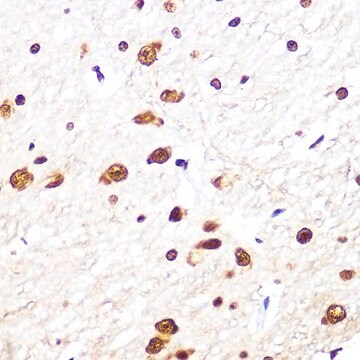MABE50
Anti-Phosphoepitope SR proteins Antibody, clone 1H4
clone 1H4, from mouse
Synonym(s):
Ser-Arg-rich proteins
About This Item
Recommended Products
biological source
mouse
Quality Level
antibody form
purified immunoglobulin
antibody product type
primary antibodies
clone
1H4, monoclonal
species reactivity
rat
species reactivity (predicted by homology)
human (based on 100% sequence homology), mouse (based on 100% sequence homology)
technique(s)
immunocytochemistry: suitable
immunoprecipitation (IP): suitable
western blot: suitable
isotype
IgG1κ
shipped in
wet ice
target post-translational modification
unmodified
General description
Immunogen
Application
Immunoprecipitation Analysis: A representative lot was used by an independent laboratory in IP (Buratti, E., et al. (2007).
Epigenetics & Nuclear Function
RNA Metabolism & Binding Proteins
Quality
Western Blot Analysis: 0.025 µg/mL of this antibody detected SR proteins in 10 µg of L6 plus insulin cell lysate.
Target description
This antibody recognizes the family of SR proteins which consist of 75, 55, 40, 30, 20 kDa proteins.
Physical form
Storage and Stability
Analysis Note
L6 plus insulin cell lysate
Other Notes
Disclaimer
Not finding the right product?
Try our Product Selector Tool.
Storage Class Code
12 - Non Combustible Liquids
WGK
WGK 1
Flash Point(F)
Not applicable
Flash Point(C)
Not applicable
Certificates of Analysis (COA)
Search for Certificates of Analysis (COA) by entering the products Lot/Batch Number. Lot and Batch Numbers can be found on a product’s label following the words ‘Lot’ or ‘Batch’.
Already Own This Product?
Find documentation for the products that you have recently purchased in the Document Library.
Our team of scientists has experience in all areas of research including Life Science, Material Science, Chemical Synthesis, Chromatography, Analytical and many others.
Contact Technical Service





![Digoxigenin-11-dUTP, alkali-labile =85% (HPLC), solution, pkg of 25 μL (11573152910 [1 mM]), pkg of 125 μL (11573179910 [1 mM]]])](/deepweb/assets/sigmaaldrich/product/images/352/091/ef743cea-ccd8-44f1-8f3b-dec5a1e4f5d1/640/ef743cea-ccd8-44f1-8f3b-dec5a1e4f5d1.jpg)


